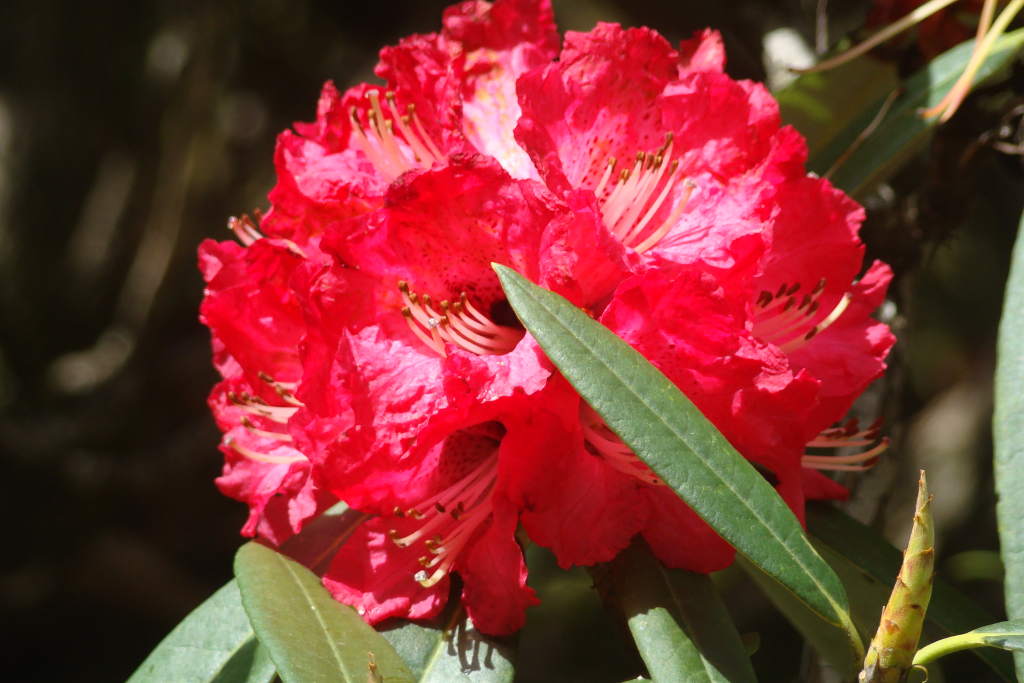
Rhododendron arboreum (Lal Brass)
Rhododendron arboreum, commonly known as Lal Brass or the tree rhododendron, is one of the most iconic flowering plants in the mid-Himalayan ranges and a botanical treasure of the Great Himalayan National Park (GHNP). Its brilliant red flowers and evergreen foliage add color and ecological richness to the forests where it grows, especially during the spring months.
Habitat and Distribution in GHNP
In the Great Himalayan National Park, Rhododendron arboreum is typically found between 2,000 and 3,000 meters above sea level, flourishing in temperate broadleaf forests, often growing alongside oak (Quercus spp.), deodar (Cedrus deodara), and fir (Abies spp.). These forests, with their cool climate and moist soil, provide the ideal environment for this species to thrive.
Botanical Characteristics
Rhododendron arboreum is a small tree or large shrub that can grow up to 12 meters tall. It is easily recognized by its dark green, leathery leaves and clusters of vibrant crimson to deep red bell-shaped flowers, which bloom between March and May. The underside of the leaves often has a silvery or cinnamon-colored coating, which helps distinguish it from other rhododendrons.
Ecological and Cultural Importance
This species plays a significant role in the ecology of GHNP. Its flowers provide nectar for pollinators such as bees and birds, especially sunbirds, during the early spring when few other flowers are available. The dense foliage also offers shelter for small mammals and birds.
Culturally, Lal Brass holds a special place in the lives of Himalayan communities. The flowers are often used to make local juices and squashes, which are not only refreshing but also believed to have medicinal properties, such as aiding digestion and reducing altitude sickness symptoms. However, excessive consumption is avoided, as the flowers contain toxic compounds in high doses.
In addition, the wood of Rhododendron arboreum, though not very durable, is sometimes used for making walking sticks and firewood in local villages. However, such use is now discouraged within protected areas like GHNP to preserve the natural ecosystem.
| Local name | Lal Brass, also known as burans or gurans |
| Botanical name | Rhododendron arboreum |
| Family | Ericaceae |
| Description | It is found at an altitude of 1500-3000m and leaves are oblong in shape. Flowers are red in colour. |
| Distribution | Rhododendron arboreum, is an evergreen shrub or small tree with a showy display of bright red flowers. It is found in Bhutan, China, India, Myanmar, Nepal, Sri Lanka and Thailand. It is commonly found in all the valleys of GHNP |
| Flowers & Fruits | May-June |
| Uses | The flower powder snuffed to stop nose bleeding, flower juice is given to children to cure blood dysentery. Wood used for fuel and charcoal. It is popularly believed that if some spines or pieces of fish bone get struck up in the mouth of a person those spines are removed by eating the Rhodendron flame. Flowers are presented as offerings in the hill temples. Flowers are sold as a vegetable for making chutneys with Pomegranate seeds and flowers are also used to make squashes by HPMC on large scale and is believed to help control the blood pressure of human beings. |
Conservation Significance
Rhododendron arboreum is considered a keystone species in many Himalayan ecosystems. Its presence indicates a healthy forest environment, and it contributes to soil stabilization on steep slopes through its root systems. Conservation of this plant is essential not just for its beauty, but for the overall health of the montane forests in which it grows.
Conclusion
Rhododendron arboreum (Lal Brass) is more than just a beautiful plant—it’s a symbol of Himalayan biodiversity and cultural heritage. In the Great Himalayan National Park, it serves critical ecological functions, supports local traditions, and enriches the landscape with its seasonal bursts of color. Protecting this iconic species is an important part of conserving the delicate mountain ecosystems that define GHNP.



